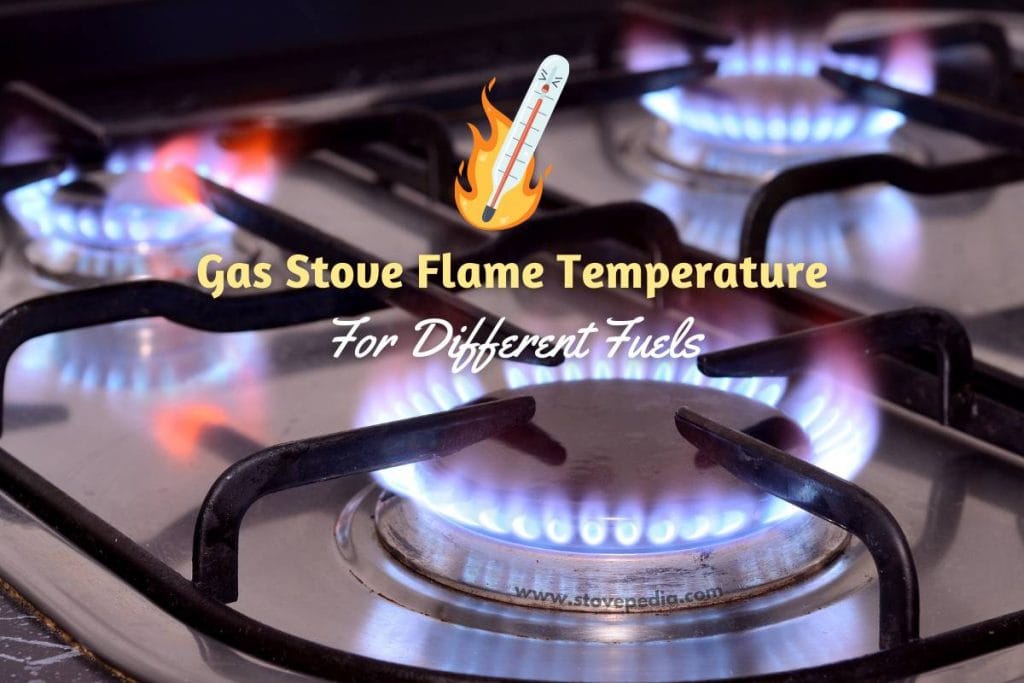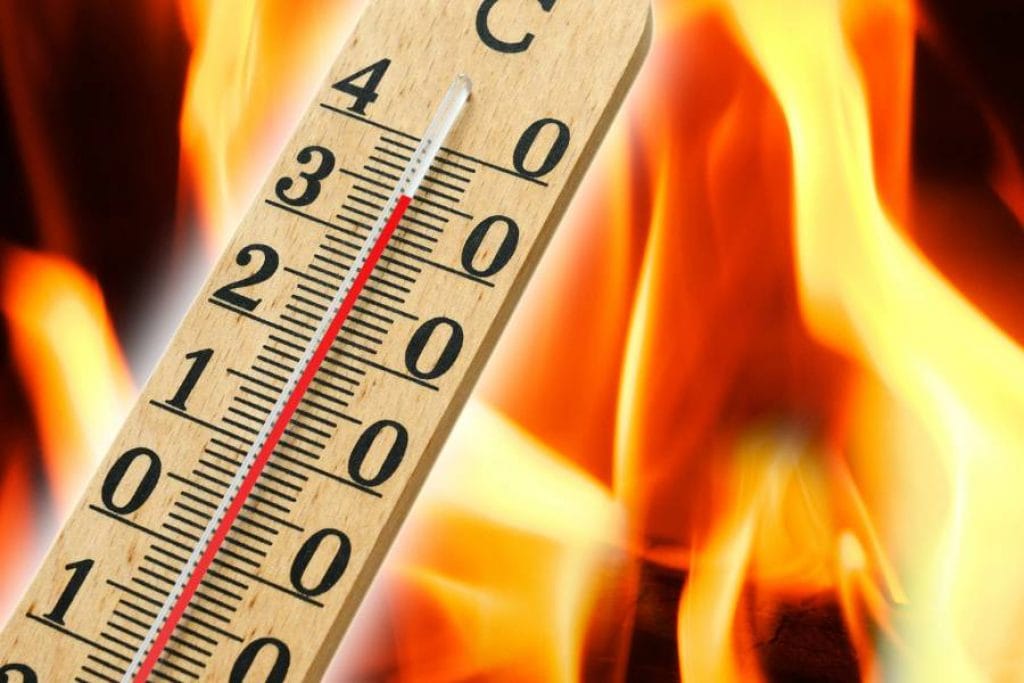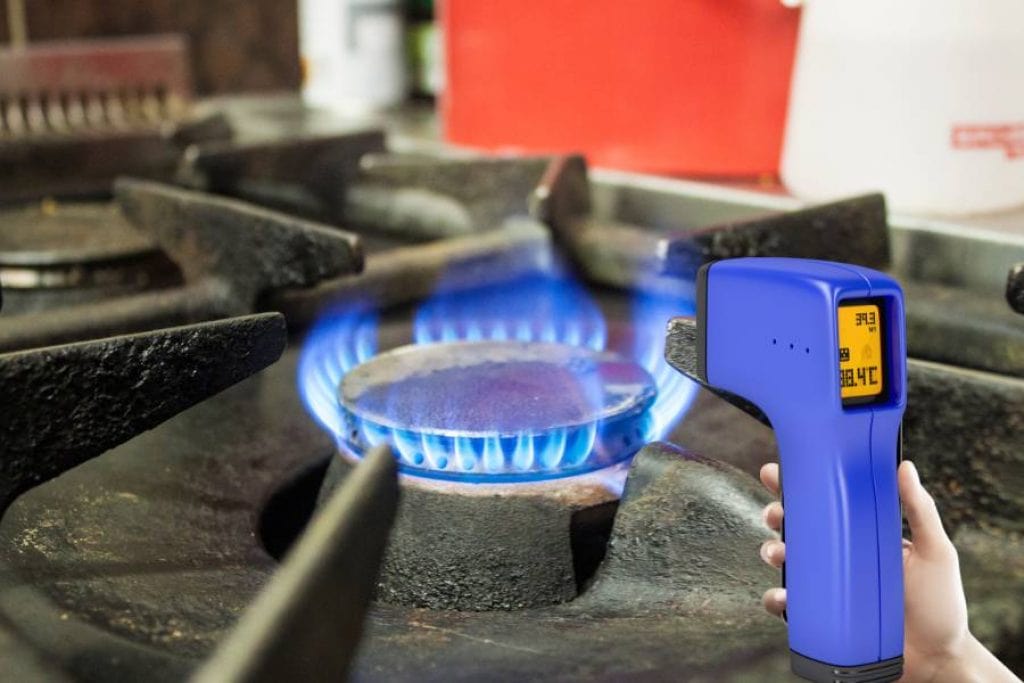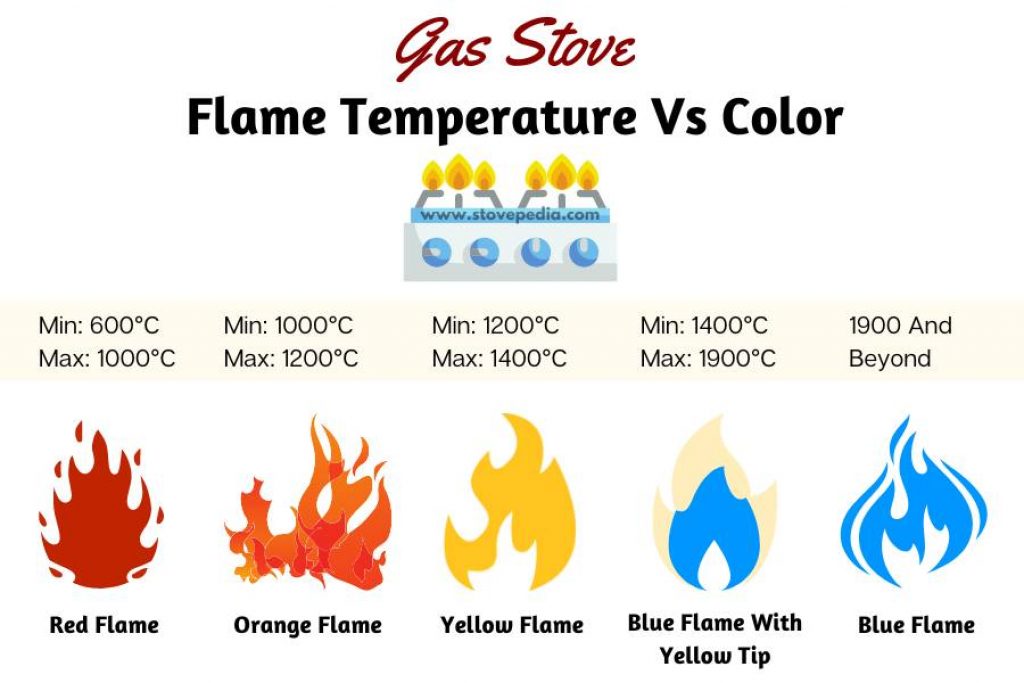Are you planning to cook a special dish that requires a specific temperature? You might then be wondering what temperature your gas stove flames burn at.
Be it the need for a specific temperature or simply your curiosity about cooking gas stove flame temperature, you have landed on the right page. As someone who cooks on a gas stove almost every day, I have personally wondered about it too.
The temperature of a gas stove flame depends on a number of factors, including whether your gas stove is working properly. I decided to carry out some research on this topic and find out more about the temperature of flames. I’d be glad to share my findings with you, and that’s what this article is about. Keep reading to learn more about the temperature of normal gas stove flames.

How Hot Are The Flames On A Gas Stove?
So, how hot exactly do you think the flame is? While it varies depending on different factors, a typical LPG gas stove flame burns at around 1980°C.
Yes, that’s quite an impressive temperature, possibly much higher than you expected. It might seem a little odd to you that when cooking on a gas stove, it doesn’t feel like you are cooking at that high a temperature. After all, almost 2000°C would burn any food in a matter of seconds, right?
The reason behind this discrepancy is that the gas stove temperature isn’t actually that hot. While the flame itself burns at a temperature close to 2000°C, some of the heat is lost, and only a portion is used for cooking. With a typical gas stove efficiency of 68%, you will get the effective temperature of maximum 1380°C for cooking.
Gas Stove Flame Temperature According To The Fuel
You may have noticed earlier that I mentioned “a typical LPG stove” when writing about the flame temperature. This is because the flame temperature of gas stoves depends on the fuel you are using in the gas stove.

Quite naturally, different fuels release different amounts of energy during combustion. However, the temperature difference isn’t much among the fuels commonly used in cooking. Let’s check out the gas stove flame temperatures for different fuels during combustion in air at a constant atmospheric pressure.
| Fuel Type | Flame Temperature |
|---|---|
| Natural gas (Methane) | 1963°C |
| Propane | 1980°C |
| Butane | 1974°C |
| Liquefied petroleum gas (LPG) | 1980°C |
| Piped Natural Gas (PNG) | 1960°C |
| Compressed natural gas (CNG) | 1960°C |
As you can see, most of the commonly used cooking gases have adiabatic flame temperatures close to 2000°C, ranging between 1960°C and 1980°C. You should also note that these are the flame temperatures you’d get while burning these gases in atmospheric air with the right air-to-fuel ratio.
How Can You Measure The Temperature Of Gas Stove Flame?
Unlike modern cooking appliances like microwave ovens, you cannot set the exact temperature of a gas stove. In case you are planning to bake or cook something that requires a very specific temperature, a gas stove can cause a bit of inconvenience.
Although it’s a bit difficult, and you may not always have the means for it, there are a couple of ways to measure the gas stove flame temperature. You will need certain equipment, depending on the method you choose.
- Infrared Thermometer: An infrared thermometer is a sophisticated instrument that can be used to measure temperature of the flame from a distance. It works by gauging the infrared radiation emitted by the movement of atoms in the target area. These thermometers can measure the temperature of the air and even flames by gauging the IR radiation and converting it into heat. However, using an infrared thermometer is tricky, and it requires a great deal of scientific knowledge.
- Pyrometer: This is an easier and simpler way to measure the temperature of the flame on a gas stove. There are two types of pyrometers – the ones that measure using visible light and the ones that measure infrared radiation wavelengths.
Unfortunately, neither of the two methods is usually good as most people don’t have pyrometers or IR thermometers at home. If you suspect that your gas stove is not working properly and the heat is lower than usual, you can get it checked by a professional who own these tools.

Simmer Settings On A Gas Stove
Although gas stoves can deliver impressively high levels of heat, you don’t always need to cook at such temperatures. You may often find yourself cooking a soup or any other dish that requires simmering rather than boiling. Now, the temperature difference between boiling and simmering isn’t much – it’s just a difference of a few degrees.
The small temperature difference can actually make a massive difference to the food you are cooking. For instance, simmering the food rather than boiling can help you cook it more synergically and enhance the taste.
Certain dishes specifically require simmering too. If you were to make a poached egg, you need to simmer it slowly. Getting the temperature too high will ruin the dish by breaking up the egg due to large bubbles and strong movements.
While you can always control the flame with a control knob in general, some gas stoves also come with unique simmer settings. These settings not only allow you to set the stove at a simmering temperature, but you can also adjust the simmering temperature more precisely. You’ll generally find three options in a gas stove with simmer settings-
- Low: Also known as slow simmer, this setting is ideal for poaching, stewing, and braising. When you simmer a liquid, you’ll barely notice a couple of bubbles and small wisps of steam.
- Medium: This is the average simmering temperature – the one you usually mean when you talk about simmering. Medium simmer is suitable for sauces, soups, stews, and braises and can be identified by gentle bubbling.
- High: This setting is quite similar to a slow boil. Also known as rapid simmer, it’s often useful when making sauces. Rapid simmering causes plenty of bubbles, but the bubbles are relatively small.
What Does The Flame Color Indicate?
If you have been using a gas stove for a while, you may sometimes notice a change in the color of the flame. Although the flame is usually blue, it may change to a different color in case there’s a problem with your gas stove and the fuel cannot combust properly.
The flame’s temperature may also change, with the combustion process producing less heat than usual. The main problem, however, is that the issues resulting in the flame color change can also lead to hazards. Here’s a comparison table to give you an idea-
| Flame Color | Flame Temperature | Reason | Associated Hazard |
|---|---|---|---|
| Blue | Beyond 1900°C | High energy generation due to complete combustion, resulting in the ionization of the gas atoms. | None |
| Blue with partial yellow or orange tip | 1400°C to 1900°C | Partial combustion deviated slightly from ideal conditions. | Very low carbon monoxide emission |
| Green | No specific temperature | The presence of impurities like copper salts or particles of corroded copper in the burner system. | Copper poisoning |
| Yellow | 1200°C to 1400°C | Slightly imbalanced air-to-fuel ratio with insufficient oxygen. | Low carbon monoxide emission |
| Orange | 1000°C to 1200°C | Imbalanced air-to-fuel ratio with insufficient oxygen. | Medium carbon monoxide emission |
| Red | 600°C to 1000°C | Highly imbalanced air-to-fuel ratio with insufficient oxygen. There can be partial blockage on the burner or pipeline. | High carbon monoxide emission. |

What Color Should The Gas Flame Be On Your Stove?
If you’re new to using a gas stove, you might be wondering about what flame color should you ideally have. As shown in the table above, blue flames offer the most heat and do not come with any associated hazards.
Not yellow flame, orange flame, or red flame, blue is the color a gas flame should be on your stove. When a gas stove is working properly with enough air in the system, it generates completely blue flames.
There are three main reasons why you should make sure your gas stove flame is always blue-
- Yellow, orange, and red flames generate insufficient heat, burning at almost 60% of the temperature of a blue flame. This increases fuel consumption by requiring you to cook for longer. Besides, the food may not cook properly if it doesn’t receive adequate heat.
- The high carbon monoxide emitted when the gas burns with insufficient oxygen are incredibly hazardous. It can land you in the hospital or even prove to be fatal.
- When copper salts burn with the fire, it generates toxic copper fumes from a green flame. Besides the hazard of accidentally inhaling these fumes, they can also contaminate your food.
In case you notice a change in your gas stove flame, you should investigate the cause immediately and fix it. If necessary, get your stove checked and serviced at a service center.
The Conclusion
I hope I have been able to satisfy your curiosity regarding gas stove flame temperature and that you found all the additional information to be helpful too. As long as your stove is working properly, you should be able to get sufficient flame temperature for cooking. This is enough for most Indian dishes, which is why gas stoves are perfect for Indian cooking.
Whether you use LPG or PNG for cooking shouldn’t matter much, as both fuels deliver similar levels of heat. However, the two require different air-to-fuel ratios, which is something to keep in mind. This is why you need to adjust an LPG gas stove before you can use it with PNG or vice versa.
Always make sure the air-to-fuel mixture ratio is alright; insufficient air may result in potential hazards. It’s a good idea to invest in a quality gas stove from a reputed brand for optimal heat, efficiency, and safety.

